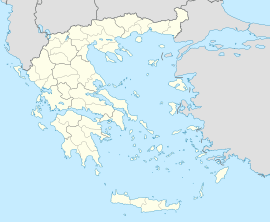Samarina facts for kids
Quick facts for kids
Samarina
Σαμαρίνα
|
|
|---|---|

Panoramic view
|
|
| Country | Greece |
| Administrative region | Western Macedonia |
| Regional unit | Grevena |
| Municipality | Grevena |
| Area | |
| • Total | 97.245 km2 (37.547 sq mi) |
| Elevation | 1,450 m (4,760 ft) |
| Population
(2021)
|
|
| • Total | 253 |
| • Density | 2.602/km2 (6.738/sq mi) |
| Time zone | UTC+2 (EET) |
| • Summer (DST) | UTC+3 (EEST) |
| Postal code |
511 00
|
| Area code(s) | 24620 |
Samarina (Greek: Σαμαρίνα, Aromanian: Samarina, Xamarina, San Marina) is a beautiful village in Greece. It is located in the Grevena area of West Macedonia. Samarina is part of the larger Grevena municipality.
This village is special because many of its people are Aromanians (also called Vlachs). In 2021, about 253 people lived there. Samarina is a popular spot for tourists. They come to enjoy its amazing views and lovely pine and beech forests. The area of the village is about 97.245 square kilometers (37½ sq. mi.).
Samarina is one of the most famous Aromanian villages in the Pindus mountains. Its people are very proud of their history and traditions. Every summer, on August 15, there is a big celebration. This is for the feast of the Dormition of the Virgin. Samarinans from all over the world come back to their village. They gather in the main square outside the Great Church. There, they perform a special dance called the "Great Dance" (Greek: Tranós Chorós, Aromanian: Corlu Mari). Thousands of people hold hands in big circles. They walk slowly and sing traditional songs together.
Contents
Where is Samarina Located?
Samarina is found on the eastern side of Mount Smolikas. This mountain is the highest in the Pindus range. It is also the second-highest mountain in all of Greece. Samarina sits very high up, between 1380 and 1515 meters (4528 to 4970 feet). This makes it one of the highest villages in Greece. It is also one of the highest in the Balkans region. Other high villages nearby include Aetomilitsa and Seli.
What is Samarina's Climate Like?
Samarina has a climate that brings cold winters and warm, drier summers. It gets a lot of rain and snow in winter. The summers are usually warm and sunny.
| Climate data for Samarina | |||||||||||||
|---|---|---|---|---|---|---|---|---|---|---|---|---|---|
| Month | Jan | Feb | Mar | Apr | May | Jun | Jul | Aug | Sep | Oct | Nov | Dec | Year |
| Mean daily maximum °C (°F) | 0.52 (32.94) |
3.03 (37.45) |
7.13 (44.83) |
11.08 (51.94) |
16.84 (62.31) |
21.14 (70.05) |
25.05 (77.09) |
25.10 (77.18) |
21.82 (71.28) |
15.16 (59.29) |
7.84 (46.11) |
2.81 (37.06) |
13.13 (55.63) |
| Daily mean °C (°F) | −2.66 (27.21) |
−0.97 (30.25) |
2.11 (35.80) |
7.01 (44.62) |
12.07 (53.73) |
16.37 (61.47) |
19.51 (67.12) |
19.43 (66.97) |
14.62 (58.32) |
9.22 (48.60) |
3.24 (37.83) |
0.24 (32.43) |
8.35 (47.03) |
| Mean daily minimum °C (°F) | −5.30 (22.46) |
−3.30 (26.06) |
−1.30 (29.66) |
1.99 (35.58) |
4.31 (39.76) |
8.29 (46.92) |
10.78 (51.40) |
10.52 (50.94) |
6.01 (42.82) |
2.12 (35.82) |
−0.39 (31.30) |
−3.31 (26.04) |
2.53 (36.56) |
| Average precipitation mm (inches) | 267.55 (10.53) |
300.39 (11.83) |
217.18 (8.55) |
174.16 (6.86) |
123.98 (4.88) |
77.84 (3.06) |
69.90 (2.75) |
70.89 (2.79) |
77.1 (3.04) |
164.54 (6.48) |
283.58 (11.16) |
365.24 (14.38) |
2,192.35 (86.31) |
| Mean monthly sunshine hours | 99.19 | 125.85 | 141.21 | 164.69 | 212.79 | 275.24 | 288.62 | 252.93 | 189.78 | 150.20 | 101.84 | 78.98 | 2,081.32 |
| Source: Hellenic National Meteorological Service | |||||||||||||
Samarina's History
This village in the Pindus mountains, with its Aromanian population, had times of great growth and cultural development. On old maps, it was sometimes called Santa Marina. The people of Samarina used to raise sheep and goats. They also made a special woolen fabric called flokati. They sold this fabric at local markets.
Samarinans were also good at trading. They used mules to carry goods in long caravans. These caravans traveled all over the Balkans. The village became very cultured, with churches, schools, and even a library. Its religious paintings were very beautiful. Samarina was at its best in the late 1700s and during the 1800s. Its success came from many activities. These included raising animals, small businesses, trade, and the arts.
A book called Nomads of the Balkans (1914) tells us a lot about the Aromanian people in Samarina. It describes their lives and customs in the early 1900s.
There is a famous Greek folk song called "Children of Samarina." This song is about brave local volunteers. They fought and lost their lives in the Greek War of Independence in 1821. The song especially remembers the heroic "Exodus of its Guards" from Messolonghi.
Samarina was the birthplace of Alcibiades Diamandi and Nicolaos Matussis. These individuals were known for supporting local Aromanian ideas during World War II. The revolutionary Ioannis Arkoudas also came from Samarina.
Famous People from Samarina
Many notable people have come from Samarina:
- Zicu Araia (1877–1948), a poet and schoolteacher.
- Alcibiades Diamandi (1893–1948), a businessman and politician.
- Nicolaos Matussis (1899–1991), a lawyer and politician.
- Jiří Staca (1884–1958), a language expert and translator.
Also, the father of Andreas Tzimas, a Greek politician, was from Samarina. Andreas Tzimas was sometimes known as Vasilis Samariniotis.


